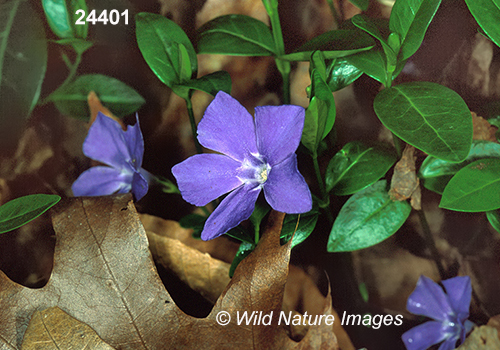| Lesser Periwinkle (Vinca minor) Linnaeus 1753 |
| Synonyms: Dwarf Periwinkle, common periwinkle, creeping myrtle, Pervinca heterophyla, P. procumbens, Vinca acutiflora, V. intermedia, etc. |
Vinca minor is a trailing, evergreen subshrub native to central and southern Europe (from Portugal and the Baltic Sea, east to the Caucasus), Turkey, and northern Africa. It was introduced into North America in the 1700s, has escaped cultivation, and colonized natural areas throughout the eastern United States and southern Canada, and also on the West Coast. Lesser Periwinkle grows in sandy soils in deciduous forests, woodlands, bluffs, banks, roadsides, parks, etc. In North America, V. minor is classified as an invasive species; it spreads vegetatively through rhizomes and forms dense and extensive clonal colonies along the forest floor, displacing native herbaceous and woody plants. Once established, it is difficult to eradicate. The leaves are opposite, dark green, and glossy. The flowers are blue, lavender or white; they attract bumblebees, bees, and other pollinators in Europe, but few insects in North America. Blooming occurs from early spring to mid-summer.






